Translation series on “Heroes of 1857”, by Sayyada Anees Fatima, Episode V (First Ed., 1949)
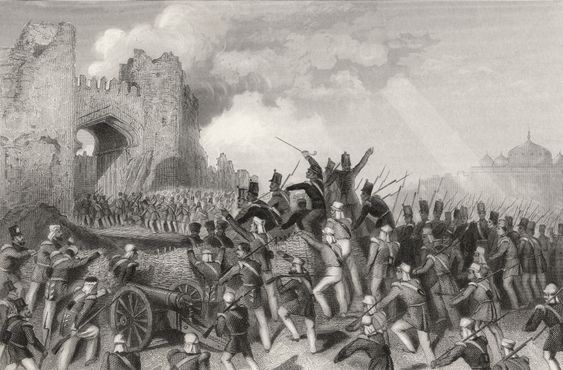
The news of Delhi’s fall struck like a whiplash and the intensity of the raids (by the rebels) multiplied. A public announcement was made by Feroz Shah.
Qaiser ul Tawarikh – Page no. 264
All the general public is notified that when the infidels conquered Delhi, they didn’t spare any lives. Similarly, your offspring will get killed. It is a matter of shame if women and children are killed or humiliated in front of your eyes. O brave people! These white men are not more than 5000…we will live in peace forever if they are all killed, (Feroz Shah).
Feroz Shah was son of Nazim Bakht and maternal grandson of Delhi’s King Farrukhsiyar. He left for a Hajj Pilgrimage and by the time he reached Indore the rebellion of 1857 had ignited. He stayed there after listening to this news and brought Fighters from Gwalior to Akbarabad and encircled Agra but was defeated and travelled to Mewat. Taking General Abdul-us-Samad Khan and Fazal Ali Risaldar, he reached Bareilly through Lucknow and Shahjahanpur, but no strategy worked. After facing defeats in Delhi and Lucknow he roamed in the forests of Bikaner and later left for Kabul and then Iran. People in Hijaz (KSA) saw a Fulvous colored dress and recognized Feroz Shah. During the war of independence, Khan Bahadur Khan who was the Ruler of Rohilkhand at that time gave him a lot of protocol and respect. At Nakatia Bridge which was a few miles away from Bareilly, he fought with valor against Englishmen but after facing defeat, Khan Bahadur Khan came to Lucknow and became a guest of Hazrat Mahal. Prince Feroz Shah had some disagreement with Ahmed Ullah Shah. Bidding farewell to Lucknow he moved to Mahmudabad. Here he gathered a sizable group of fighters and decided to fight again. He made a very effective speech in which a quote is worth contemplating, ‘I dedicate my body till death, whoever is ready to die may join me otherwise there is an option to leave’. It was heard that at the time of speech Prince (Feroz Shah) was starving for the last three days. In a book ‘’Alm-o-Amal Waqa-e- Abdul Qadir Khani’’ by Dr Ayyub Qadri it is written that Feroz Shah’s mother’s name was Abdi Begum and she was daughter of Mirza Mungo. Mirza Mungo was the nephew of Shah Alam Sani (The second). After the defeat in the First War of Independence. Prince Feroz Shah ‘s exploits can be traced up to 1869. Probably he died in Turkey (or some say in Mecca). Later in Circa 1882 a monthly financial assistance of Rs Five thousand or Ten thousand was recommended for his widow by the British resident to the Government of India.The recommendation letter has been seen by the author (Sayyada Anees Fatima).

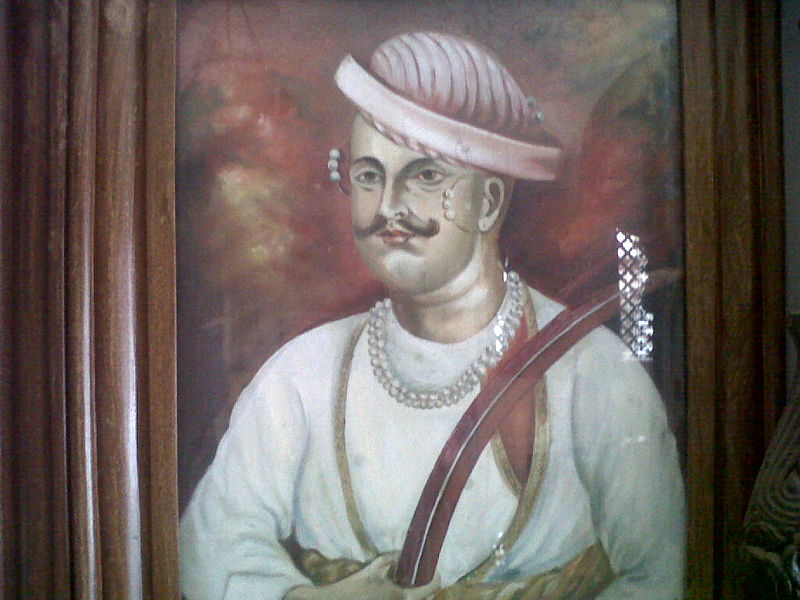
Nana Saheb and General Bakht Khan also came during that time and stayed as a special guests of Hazrat Mahal. The presence of these devoted patriots and the perseverance of Hazrat Mahal stretched this battle till 1858.
In original Urdu account Nana Saheb was mentioned with name of Nana Rao with this descriptive note. Nana Rao was the last sovereign of the Maratha Empire. The 1857 rebellion was plotted by him and General Azeem Ullah. In Kanpur they started the movement with force and passion. General Azeem Ullah Khan was a patriot and had excellent command on English language. His laudable attributes can be gauged from the letters he wrote to an English lady friend, which were later found by soldiers during the loot and plunder at the Palace of Nana Rao in Kanpur. In one of the last letters he writes, “We the eastern folks consider life to be very trivial. My country needs me. The emotion which the world calls patriotism has shaken me. There is darkness enveloping the whole country, but I am hopeful that long after my death. The sacrifice I render may blossom into a flower of optimism sown by times. I have burnt my both hands in the blazing fire of life without regret…’’
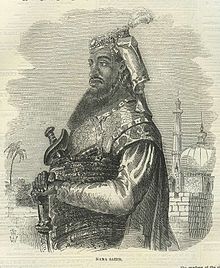
After Kanpur’s defeat, Tantia Tope also came to Lucknow. Hazrat Mahal led him to Sheesh Mahal (Palace of Mirrors) & eleven cannon’s salute was accorded. And they were also presented with a precious handkerchief, vestment and gifts worth 25000 rupees.
Maulvi Zaka Ullah wrote, “Seventy to eighty thousand brave men were streamlining their stronghold with persistence and caution. The National dignity and strong religious faith had turned them into tenacious fighters, under the command of a lady, Hazrat Mahal who was the Vice Ruler of City’’.
An Englishman named Fielding wrote, during the time of the Rebellion, the headcount of the English soldiers was very less. Intermittent attacks by the rebel fighters further depleted this number. Therefore, Henry Lawrence wrote to Sir Colin Campbell, “If the reinforcement will not arrive then they will not be able to keep their hold on residency for more than ten to fifteen days’’.
Condition of Rebel Fighters
Forbes Mitchell (part of EIC forces) wrote that a posse of Archers were appointed on the walls of Shah Najf. They were so expert in archery that whoever among us used to raise their head high was immediately targeted. One arrow ripped through the forehead of a soldier, coming out one foot from the opposite side. Another soldier took an arrow to his chest which also went through, dragging him some 3-4 yards. This soldier suffered 6-7 feet above the ground before dropping dead. The three slogans of Deen, Deen! , Allah Hu Akbar and Jai Kali Mai kept constantly reverberating..

by Thomas Jones Barker Source: National portrait Gallery
Retrieved from https://www.npg.org.uk/collections/search/portrait/mw08481/The-Relief-of-Lucknow-1857
Internal Treason
But like Bengal and Delhi, there was a continuous series of internal treason. This hardship of Bailey guard was not because of the bravado of English Army but owing to conspiracies hatched by traitors of the country. Hence the author of Qaiser ul Tawarikh penned, “At the time of the first attack by the Englishmen upon orders of Hazrat Mahal, the doors of Qaiser Bagh (Garden) were closed. Najeebabadi Telanga troops cursed residents of Lucknow city as if they had not delivered supplies to Bailey Guard, the Englishmen would starved to death.’’
Other reasons of defeat
Maharaja Bal Krishan who apparently exhibited a lot of compassion in front of Hazrat Mahal but was hand in glove with the Englishmen. He tricked all Taluqdars (Landholders who collected tax on behalf of sovereign) into returning to their respective areas. Due to extreme paucity of funds Hazrat Mahal also was caught in the snare of his deception. Bal Krishan came up with the excuse that if they (Taluqdars) won’t go back to their areas, how the taxes will be collected from their respective dominions; Bulls eye! as the return of the Taluqdars with their militias till March 1858 certainly gave rise to a sense of dejection in the rebellion movement. But despite this setback, Hazrat Mahal’s courage was not decreased even a speck and the tumultuous events of rebellion continued with zeal.
Bal Krishan was appointed as Finance Minister by Hazrat Mahal but he turned out to be a traitor (Ref. Tareekh-e-Jang-e-Azadi Page 21). Mitchell wrote that the trench near Begum’s (Hazrat Mahal) mansion was filled with the corpses of enemies (Rebel Fighters).
Maharaja Nepal‘s collusion with East India Company
Right amidst the War, Jang Bahadur, the Prime Minister of Nepal headed out of his country with a large division and moved in the direction of Awadh. The rebellion which Sir Colin Campbell and General Outram were unsuccessful to quell despite all efforts was quashed by Jang Bahadur and his army. Under the shadow of Nepali guns and swords Campbell and Outram raised again to conquer Awadh, that Awadh which according to Governor General Lord Kenning, was harboring the largest number of rebels.
دوست نے خاطر دشمن سے کیا مجھے ہلاک
Trans. Friends killed me by providing relief to the enemy.
(ref. Pinnacle of British Colonialism): Raja Balram assisted British with all means. One Englishman penned that approx. three days they stayed at Balram but the Raja (Balram) cautioned that staying here was not wise and he wrote a letter addressed to Raja Nepal ‘’Please protect these people by all means’’’. He gave us another letter written to his brother-in-law who was a big landholder or Raja of Gorakhpur district.
Begum Hazrat Mahal and Non-Muslims
In Awadh Begum Hazrat Mahal was supported by Hindus to such an extent that the soldiers had a common impression that after victory the Hindu Religion will gain prominence. They were not threatened by the Muslims and trusted them a lot. This was evident from the large proportion of Hindus in the rebel forces. Sir Evenson Wood recorded in his book “Rebellion in Hindustan’’ that Hindus were afraid of being forcibly converted to Christianity. Those very rebel Hindu soldiers who were with Hazrat Mahal made an appeal to Jang Bahadur (PM of Nepal) in April 1859 which stated that since they were fighting for Hindu religion so Maharaja Nepal who himself was a Hindu should help them.
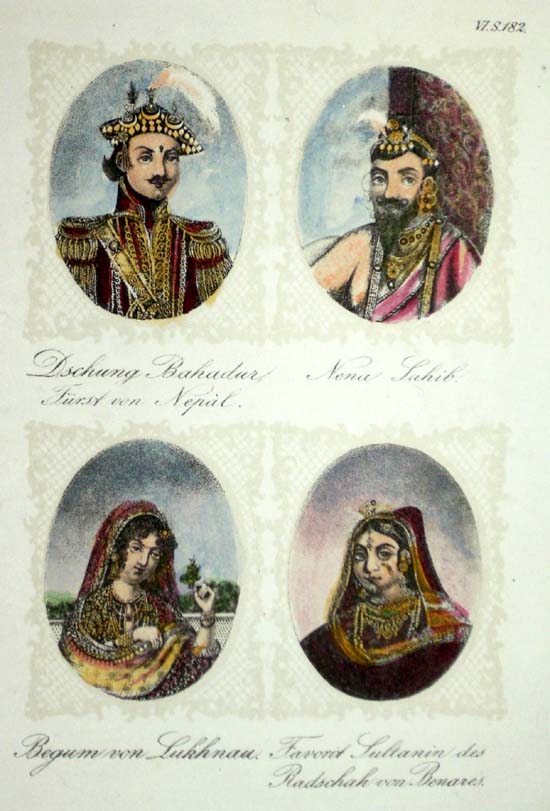
The Audacity of the Fighters
The invasion of the English and Nepalese forces was blocked by the clerics and fighters who drenched themselves in the pool of blood. Still Jang Bahadur left Gorakhpur on 14th February for the Capital of Awadh. His ally General Rocroft came to know that Phoolpur is swarming with rebels so Jang Bahadur went in the direction of Lucknow via Sultanpur. On route to Lucknow two bloodied battles were fought in which rebels faced Nepalese valiantly. During these fights traitors of the country also continued their conspiracies in which Raja Balrampur was at the forefront.
Exhibition of Decency
When Hazrat Mahal was leaving for Nepal the situation was very delicate. At that time Rana Beni Madhu Singh of Shankarpur exhibited a great degree of decency and bravery. It is said that when he handed over his Fort to General Hope Grant’s battalion, then Englishmen came under the impression that Rana is inclined towards truce. Hence, he was presented with relatively lenient terms of truce by the Englishmen. Rana noticed this gesture and instead of thanking them he showed patriotism and decency by this reply to the British envoy, I was unable to protect my Fort therefore I handed it over to you. But I can’t turn myself in, because I owe my existence to the King (Birjis Qadar) and Begum Hazrat Mahal. Therefore, he and his battalion went to Nepal with the Army of Hazrat Mahal. The stretch of thirty three miles, on a road from Gorakhpur to Sultanpur was filled with rebels. The biggest concentration was at Mug Rampur and Chanda. Mehdi Hussain and Banda Hussain were the commanders of the battalion. After Mr. Franks and Nepalese army captured these areas, Zaka Ullah said “Mehdi Hussain still didn’t give up and in order to give a tough time to Nepalese Army at Badshah Ganj he assembled the defeated and dispersed army. Mirza Jaffar Baig set up an alignment near his house on the road which goes to Lucknow and also installed Canon on one side’’.
شکست و فتح نصیبوں سے ہے ملے اے میر
مقابلہ تو دل, ناتواں نے خُوب کیا
Trans. Victory or Defeat is attained through fate O Meer!
Though weak heart battled a lot
While staying put in Amethi, which is 8 miles away from Lucknow, Mr. Franks received orders from Commander in Chief that “Do not go further as Dawoodi fort is swarming with rebels’’. After discussion about Nepal we will now move forward to witness a few highlights of the battle at Lucknow.
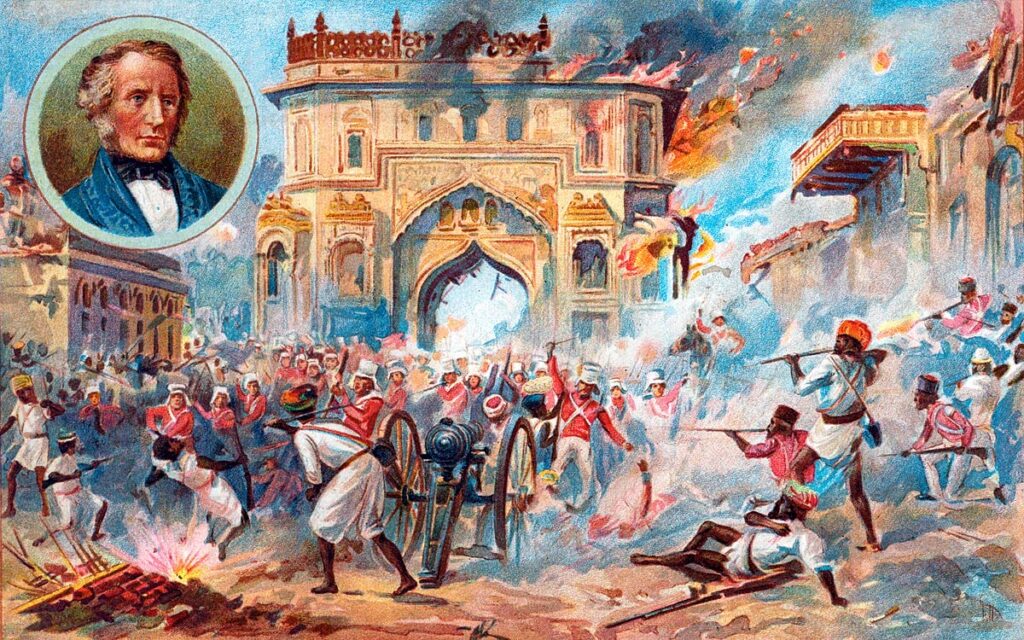
https://www.paperjewels.org/postcard/lucknow-indian-mutiny-1857
Final Glimpses of the Battle of Lucknow
Khan Ali Khan Raja was lieutenant of Nawab Ali of Mahmudabad and he was also commander of the collective battalions of Landholder/ Tax Collectors. Whereas the army of the general public (rebels) was under the command of Colonel Barkaat Ahmad. It was said that Raja Nawab Ali and Raja of Ramnagar did not cooperate at the start of the War of independence. But owing to pressure applied by the Army and allies they were compelled to join the rebel army.
The first combined Nepalese and British attack was on “Alam Bagh”. There was an intense fight at Hazrat Mahal’s mansion around which hundreds of Rebel’s bodies were seen scattered. However just before the imminent takeover of “Chulakhi”, Khan Ali Khan reached with one thousand of his soldiers.
There was a fierce battle, Alam Bagh turned into a pool of blood. Jang Bahadur ambushed the rear and hundreds fell. Khan Ali Khan was also injured. Despite knowing Chulakhi being the most obvious target for the attack.
While moving from the south gate of Qaiser Bagh towards Lal bagh, it is a majestic two storey mansion on the left side. It was built by Azeem Ullah Azam Ud Daula sahib and Warder Muhammad Ali Badshah. Wajid Ali Shah liked this mansion a lot because it was adjacent to Qaiser Bagh so he purchased it for Rs 4.7 million and named it Mashooq Manzil (Trans.Beloved Destination). But among the general public it was popularly known as Chaulakhi. After the end of the Rebellion it was auctioned to one person named Shah jee for Rs 12,000 and later Nawab Wazeer Mirza purchased it for Rs 40,000.
Hazrat Mahal was not willing to leave it on any condition. Nevertheless, at the home at Chulakhi, there was an intense fight between British and the rebels. The account of which has been written by the British authors, but it’s obvious they have talked about the rebels in a derogatory manner. Before including the important accounts of these authors, we present a memoir of a family, from Bhatwa Mayo which was an administrative district. who participated in this fight. This excerpt has been taken from a book “Aasar e Yaadgaar” (Trans: Monuments of a memory) published in 1904. This book is now scarce. When the hubbub of news of British forces entering the city reached, mob after mob set out for the barricades. The fight started in Alam Bagh. It was the 6th of “Safar”, Friday the 25th of September 1858, 10 o’clock in the morning. A subordinate reached from the respected Begum through the Government rest house, to summon Tajamul Hussain Khan (Landlord of Bhatwa Mayo). Here the food was served. Just as everyone, ready with their washed hands, was about to take the first bite, the second person arrived. And this ensued until a message was received from the Respected Begum, “will you leave from there when my respect (Would be in the hands of the British?)”. As soon as they listened to these words, all three brothers stood up from the Serviette, armed themselves with their weapons, and mounted their horses. Leaving few of their companions at the retreat and few at the Bailey Guard’s battlefront, they reached the royal abode with an estimated headcount of 200. Mammo Khan delivered an order to fight the British from the Respected Begum presenting 10,000 rupees as a military expenditure. Nabi Bakhsh Khan and his people refused to take the money and right away started for the Barricade of “Handalna”. The remaining rebel forces, along with the rest of the citizens and the people from the surrounding districts, thus everyone headed for Alam Bagh ready to fight that day. It was hard finding space en route due to the excess of the crowd. Raja Nawab Ali Khan (Mahmudabad) who was Nabi Bakhsh Khan’s uncle, was reposed in Amin Ud Daula’s house. Raja Sahab heard about all three brothers going in the direction of Alam Bagh with the resolute determination to fight. He came anxiously to the barrier, which happened to be on the way, brimming with the emotions of extreme affection. They advanced, upon reaching the Handolna’s barricade their intention was to attack after crossing the canal bridge but faced difficulty in the path ahead due to the multitude of abundant crowds. Right at that point, there was a constructed garden and standing beneath one of its walls, there was an alley on their side. They sent some companions in that direction to find out if the path is clear and if they can exit through it. Just as they watched them go away, they were surprised to see the same multitude of an abundant crowd coming back. Eventually there was no other option. The wall was dug up by the shovel holder companions and they entered the garden from one side. The horses had to be left outside the garden. And Lo and behold, the British were seen coming in the direction of the garden road because of their non-familiarity of the way. In short, under the mosque of Ghulam Hussain, a fight was commenced with Nabi Bakhsh Khan and his companions. At the time, from their side there were the three brothers, and their brother in law, Sheikh Ahmad Hussain Fatehpuri and Mir Hussain Ali, real cousin of Naogoan’s resident Ali Bakhsh Khan (deceased), and some other special personalities and brothers including Haji Akbar Ali (Mahmudabadi). Excluding them the rest of the army did not return from the exploration of this path. There was gunfire from all sides, first Tajamul Hussain Khan was wounded. He took a bullet in his right hand. Haji Akbar Ali Khan proceeded to inform Nabi Bakhsh Khan. Later Kazim Hussain Khan was wounded. He was shot in his left foot, Haji Akbar Ali told Nabi Bakhsh Khan, “see the younger master has also been injured”. An irate Nabi Bakhsh Khan shoved him aside, telling him that “you want to make me a coward by showing me the blood of my young brother. Is that why you have come here? Let death come, this isn’t a place where sweets are distributed”. Kazim Hussain Khan’s Gun stone was wasted during the fight. Brother in arms was standing nearby. He calmly took another stone from him, replaced it, then loaded the gun and took a shot. There was a bullet shower from the opposite direction during all this time. Nabi Bakhsh who was watching from the corner of his eye highly praised this persistence. Subsequently, Sheikh Ahmad Hussain also was injured and fell. Nabi Bakhsh Khan was shot at the temple, he staggered and fell quickly embracing martyrdom. Meer Hussain Ali also served the purpose. The fight ended by the time of “Zuhr” (prayer). The British fled and returned from Martin’s villa towards the road which came to the city and entered from that direction. That’s how respected Begum got a chance to exit the city with respect and honor. In this fight nineteen were injured and killed from this side. And twenty one on the opposite side perished. At this moment, those companions who went to discover the way also came back.
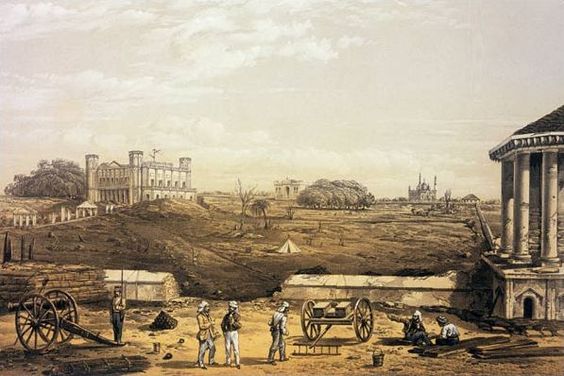
A Valiant Mother
The Palanquin carriers supported their bearings, consisting of Hussain and the victims and carried them to the bivouac. Upon reaching there they discovered it was already attacked and ransacked of all the valuables by the British. Without much choice under the state of sheer helplessness they reached Bhatwa Mayo the next morning. The palanquins of all three brothers were kept in the women’s quarter. Nabi Bakhsh Khan’s mother came and saw the state of her three young sons. In the catatonic state of agony and desolation, they found their lives had ended. These were the only words she uttered, the first word escaped her was this, “O God Almighty I am grateful, that they have come before me like this, after being bravely engaged in facing the enemy at the war. They have kept the honor of the family. I am content with them and forgive them my rights as a mother”. The victims were buried.
Fighter’s spirit of freedom
This very spirit of freedom engulfed the whole Lucknow and everyone in it, from a commoner to an elite. About Begum Hazrat Mahal’s departure to Lucknow, Mirza Ali Azhar Barlaas wrote in his famous book “Tareekhi Shehpaaray” (Trans: Historical Verism)
Respected Begum would have been arrested, but at the very last moment Khan Ali Khan entered in Qaiser Bagh and fought with bravery, leading to a tremendous loss faced by the British.
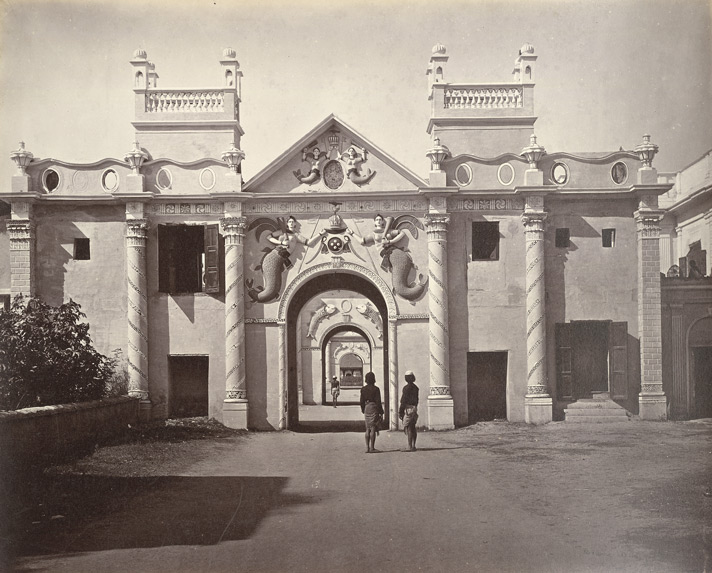
Retrieved from http://www.bl.uk/onlinegallery/onlineex/apac/photocoll/m/019pho000000394u00056000.html
Maulvi Ahmad Ullah Shah’s bravery
The chance for the respected Begum along with her companions, to leave Lucknow reverently was also provided by Maulvi Ahmad Ullah Shah in addition to Khan Ali Khan (Mahmudabad). He provided vigorous resistance and became an invincible power in the face of the looming clouds of difficulty and failure. Holmes wrote with reference of Manjandi, some rebels in which Maulvi is included still are displaying unusual persistence. They are the only one left in the destroyed city. They too were evicted on 21st March and the siege of Lucknow ended.
Begum Hazrat Mahal’s rejection for a truce
The British presented attractive terms to convince Begum Hazrat Mahal to submission but she rejected. On 16 March 1858 respected Begum left Lucknow and bearing extreme hardships reached Baundi Taluqa of District Bahraich. She kept on fighting with determination till 1859. Because of the respected Begum, during those days the people’s veneration for the royal family increased to an unprecedented level, the account of which is given in the words of Sir Colin Campbell commander in chief, neither our threats nor sweet talk or flattery can convince the Awadh’s Chiefs to sever their relationship with the deposed king and his family, or to accept our rule.
Nawab Mammo Khan’s Advice
One day in the morning Nawab Mammo Khan tried his best to counsel Hazrat Mahal (for reconciliation) indirectly and with using hints, but there was no change in her perseverance.
سبق جس کو وفا کا یاد ہو گا
مُحبت میں وہ برباد ہوگا
شہر اُجڑا تو بس جائے گا لیکن
ہمارا گھر نہ پھر آباد ہوگا
Trans.Whoever remember the lesson of loyalty
Get devastation in love
The city if ruined may revive again
But our abode may not inhabit again
This is a translation series of Urdu account by Sayyada Anees Fatima titled “Jang-e- Azadi (Awwal)’57 kay Hero” (Trans. Heroes of the First War of Independence). It was first published in 1949 at Aligarh under the aegis of All India Muslim Educational Conference (A movement founded by Sir Syed Ahmed Khan). The author captured the melancholy, conflicts of Indian states with East India company & struggle of 1857 in a vivid story telling style integrated with contextual Persian & Urdu Poetry. The translation & contextualization is done by Sayyad Asad Ali (her grandson) & edited by Saba Saif.
Syed Asad Ali is Lahore based branch head for a Japanese company that develop large scale Industrial Projects. Reading & writing are his favorite hobbies. His fathers family hails from Bareilly, UP & maternal side was from Kishangarh, Rajasthan. He is an avid follower of pre-partition history of India.
